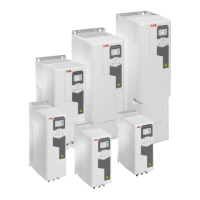Planning the electrical installation 67
Checking the compatibility of the motor and drive
Use an asynchronous AC induction motor, permanent magnet motor or synchronous
reluctance motor with the drive. Several induction motors can be connected to the
drive at a time but only one permanent magnet motor can be connected to the drive
at a time.
Check that the motor and the drive are compatible according to the rating table in
section Ratings on page 160. The table lists the typical motor power for each drive
type.
Ensure that the motor withstands the maximum peak voltage in the motor terminals.
See the Requirements table on page 68. For basics of protecting the motor insulation
and bearings in drive systems, refer to section Protecting the motor insulation and
bearings below.
Note:
• Consult the motor manufacturer before using a motor whose nominal voltage
differs from the AC line voltage connected to the drive input.
• The voltage peaks at the motor terminals are relative to the supply voltage of the
drive, not the drive output voltage.
• If the motor and drive are not of the same size, consider the following operation
limits of the drive control program:
• motor nominal voltage range 1/6 ... 2 · U
N
• motor nominal current range 1/6 ... 2 · I
N
of the drive in vector control and
0...2· I
N
in scalar control. The control mode is selected by a drive parameter.
Protecting the motor insulation and bearings
The drive employs modern IGBT inverter technology. Regardless of frequency, the
drive output comprises pulses of approximately the drive DC voltage with a very short
rise time. The pulse voltage can almost double at the motor terminals, depending on
the attenuation and reflection properties of the motor cable and the terminals. This
can cause additional stress on the motor and motor cable insulation.
Modern variable speed drives with their fast rising voltage pulses and high switching
frequencies can generate current pulses that flow through the motor bearings. This
can gradually erode the bearing races and rolling elements.
Optional du/dt filters protect motor insulation system and reduce bearing currents.
Optional common mode filters mainly reduce bearing currents. Insulated N-end (non-
drive end) bearings protect the motor bearings.

